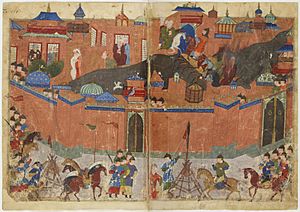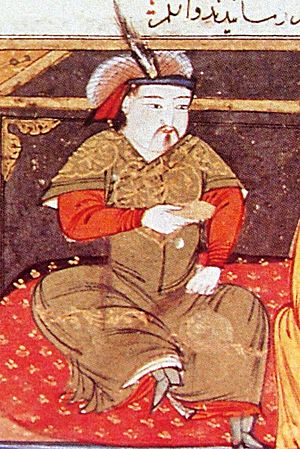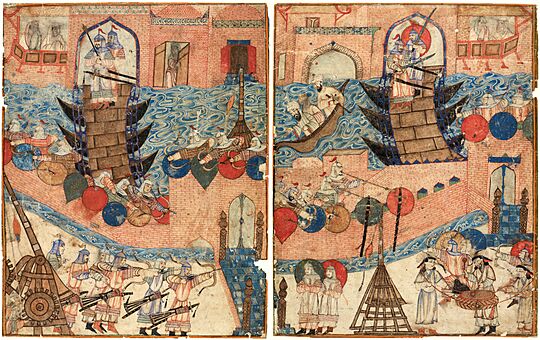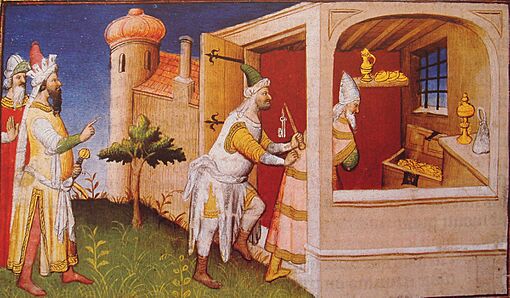Siege of Baghdad facts for kids
Quick facts for kids Siege of Baghdad (1258) |
|||||||||
|---|---|---|---|---|---|---|---|---|---|
| Part of Mongol invasions and conquests | |||||||||
 Depiction of Hulegu's army besieging the city, c. 1430 |
|||||||||
|
|||||||||
| Belligerents | |||||||||
| Ilkhanate (Mongol Empire) | Abbasid Caliphate | ||||||||
| Commanders and leaders | |||||||||
|
|
||||||||
| Strength | |||||||||
| 138,000–300,000 | 50,000 | ||||||||
| Casualties and losses | |||||||||
| 200,000 killed (according to Hulegu) 800,000–2,000,000 killed (Muslim sources) |
|||||||||
The Siege of Baghdad happened in early 1258. It was a major battle at Baghdad, which was the capital city of the Abbasid Caliphate. The city's ruler, Caliph al-Musta'sim, had upset the powerful Mongol Empire.
A huge Mongol army, led by Prince Hulegu, attacked Baghdad. In just a few weeks, the city fell. The Mongol army took over the city, and the Caliph al-Musta'sim was killed. Many people in Baghdad also lost their lives.
This event is often seen as the end of the Islamic Golden Age. However, historians now think its long-term effects might not have been as bad as once believed.
Hulegu was a grandson of Genghis Khan, the famous Mongol leader. Hulegu was sent west to secure lands for the Mongol Empire. His army was enormous, with over 138,000 soldiers. They first defeated a group called the Nizari Ismaili Assassins in 1256.
Hulegu expected the Caliph to send soldiers to help him. But the Caliph refused and was very arrogant in talks. This made Hulegu decide to attack Baghdad. The Mongol army surrounded Baghdad from all sides. They defeated the city's defenders by flooding their camp. Baghdad was left with only about 30,000 troops to defend it.
The main attack started in late January. Mongol siege engines quickly broke through Baghdad's walls. By February 4, Hulegu's skilled soldiers controlled the eastern wall. The Caliph tried to negotiate, but Hulegu wanted a complete victory. He even killed soldiers who tried to surrender.
The Caliph finally gave up the city on February 10. The Mongols began looting Baghdad three days later. The exact number of people who died is not known. Hulegu later said his army killed about 200,000. After the looting stopped, Hulegu executed the Caliph. Baghdad later recovered under Mongol rule, though it was not as important as the new capital, Tabriz.
Contents
Baghdad's Rich History
Baghdad was founded in 762 AD by al-Mansur. He was the second caliph of the Abbasid dynasty. This new dynasty needed a new capital city. Baghdad was built in a safe spot, close to the Abbasids' power base in Persia.
The city became incredibly rich. It controlled important trade routes and collected many taxes. Baghdad quickly grew into a world city. It was the center of the Islamic Golden Age. Poets, writers, scientists, philosophers, and musicians all thrived there.
Baghdad had famous learning centers like the House of Wisdom. It also had advanced astronomical observatories. People used the new technology of paper there. They also gathered ancient knowledge from all over Eurasia. One historian called Baghdad "the intellectual capital of the planet."
Baghdad Before the Mongols
Over time, the Abbasid caliphs lost some of their power. Baghdad was taken over by other groups, like the Buyids in 945 and the Seljuks in 1055. By then, the caliphs only had local power in Baghdad.
Still, Baghdad remained one of the world's most important cities. Between 1000 and 1200, it had over a million people. Only Kaifeng and Hangzhou in China were as big. The caliphate became strong again under al-Nasir (1180–1225). He fought off threats from the Seljuks and the Khwarazmians.
In 1217, the Khwarazmians tried to invade the Abbasids but failed. Soon after, the Mongol Empire under Genghis Khan invaded the Khwarazmian realm.
Mongol Expansion and Threats
After the Mongols invaded the Khwarazmian Empire in 1221, they returned to the region in 1230. A Mongol general named Chormaqan arrived in Azerbaijan. He defeated the Khwarazmian prince Jalal al-Din.
After this, the Mongols began to take control of northwestern Iran and the Transcaucasus. They captured Isfahan in 1236. The Mongols then started testing the Caliph's power in Mesopotamia. They attacked Irbil in 1237 and raided near Baghdad in 1238.
Chormaqan and his replacement, Baiju, raided the region almost every year. The Mongols secured their rule in other parts of the Near East. For example, they defeated the Seljuk Sultanate of Rum in 1243. But Baghdad remained unconquered. It even defeated a Mongol force in 1245.
Another problem for the Mongols was the Order of Assassins. This secret group in the Elburz Mountains had killed Mongol commanders. They even tried to kill the Mongol khan in his capital, Karakorum.
Hulegu's Campaign
In 1251, Möngke Khan became the Great Khan of the Mongol Empire. He decided to send his younger brothers, Kublai and Hulegu, on huge military missions. Kublai went to China, and Hulegu went west. Hulegu's job was to destroy the Ismaili Assassins and make the Abbasid caliphs surrender.
Hulegu was given a massive army. Some historians say it was between 138,000 and 300,000 soldiers. This army included engineers led by Guo Kan. It also had soldiers from different parts of the empire, including Armenia.
Defeating the Assassins
Hulegu's army moved slowly because it was so large. He started in October 1253. He spent years traveling through Transoxiana. In 1256, he entered the Assassins' homeland.
An advance group under General Kitbuqa had already taken many Assassin forts. The leader of the Assassins, Ala'ad-Din Muhammad, died in December 1255. Hulegu sent messengers to the new leader, Rukn al-Din Khurshah.
Rukn al-Din tried to delay, but his forts kept falling to the Mongols. He finally surrendered on November 19. He even convinced the famous fort of Alamut to surrender. However, some other forts refused to give up.
The Campaign Against Baghdad
Hulegu had expected the Abbasid caliph al-Musta'sim to send troops to help fight the Assassins. The Caliph first agreed. But his ministers thought the Mongols just wanted to weaken Baghdad's defenses. So, the Caliph refused.
Some later writers said Baghdad's chief minister, a Shi'ite named Muhammad ibn al-Alqami, betrayed the Caliph. They claimed he secretly talked with Hulegu. Baghdad was already in a difficult situation. There had been fighting between different Muslim groups after a flood. But the Caliph and his ministers still believed they could win.
Hulegu spent the summer of 1257 near the Hamadan plain. General Baiju rejoined him there with more soldiers. These included vassals from Seljuk, Georgia, and Armenia.
Messages Between Leaders
In September, Hulegu started sending letters to al-Musta'sim. Hulegu's first message demanded that the Caliph tear down Baghdad's defenses. He also asked the Caliph to send his three main ministers to the Mongols. The ministers refused, so three less important officials were sent instead.
Al-Musta'sim's reply called Hulegu young and ignorant. He boasted that he could call armies from all over the Islamic world. He also treated Hulegu's messengers disrespectfully. This was just "provocative bluster." The Caliph actually had few allies. The Mamluk Sultanate in Egypt was against him. The Ayyubids in Syria were busy trying to survive.
More letters were exchanged, but no progress was made. The Caliph only offered a small amount of tribute. His minister, al-Alqami, wanted to send a lot of money. But another official argued that al-Alqami was trying to empty the treasury and help Hulegu.
Hulegu grew impatient. He asked his advisors about attacking Baghdad. An astronomer warned of disaster, saying all rulers who attacked Baghdad had lost their kingdoms. But a wise scholar named Nasir al-Din al-Tusi said Hulegu would succeed and rule in place of the Caliph.
The Mongol Advance and Siege
Hulegu's army moved towards Baghdad from different directions. Kitbuqa approached from the south. Hulegu himself reached the eastern suburbs on January 22. Local Shi'ites welcomed him there.
The Mongols then completely surrounded Baghdad. They built a palisade (a fence of stakes) around the city. They also dug a moat inside this fence. These defenses were built in just one day.
They built mounds of bricks for their mangonels (catapults) and ballistae (giant crossbows). They used palm trees and stones from the suburbs for ammunition. Later, they found suitable rocks in the Hamrin Mountains. They also used fire weapons like burning naphtha.
To stop anyone from escaping by river, Hulegu built pontoon bridges across the Tigris river. Baghdad's walls were in bad shape. The city's army, about 50,000 strong, was not well trained. But Hulegu still planned his attack very carefully.
The attack on Baghdad's weakened walls began on January 29 or 30. The Mongols shot arrows into the city with messages. These messages promised safety to Christians, certain Muslim leaders, and those who surrendered.
The first break in the wall happened on February 1. But the Mongols were pushed back. Over the next two days, they made more breaks. By February 4, they controlled the eastern walls.
The Caliph's commander tried to escape by sailing down the Tigris. But Hulegu's bridges stopped him. He was forced back into the city.
The Caliph sent many messengers to Hulegu. But Hulegu wanted nothing less than a full surrender. He even killed one of his own commanders who was wounded during talks. Both the Caliph's commander and the head of Baghdad's army were handed over to the Mongols and killed.
On February 7, many unarmed soldiers and citizens came out of the city. They hoped to be spared and sent to Syria. Instead, they were divided into groups and executed.
With no other choice, al-Musta'sim prepared to surrender. He sent his son, Ahmed, who secured safety for his family. The Caliph surrendered on February 10. He brought his family and 3,000 important people with him. Hulegu told al-Musta'sim to order everyone in the city to leave and drop their weapons. Those who obeyed were killed. The Caliph and his family were kept near Kitbuqa's forces.
The City's Fall and What Happened Next
On February 13, the Mongols began to loot Baghdad. This was not just random destruction. It was a planned act to show what happens when you defy the Mongol Empire.
Some people were spared. These included Sayyids (descendants of the Prophet Muhammad), scholars, merchants who traded with Mongols, and Christians. Hulegu's wife, Doquz Khatun, was Christian. She asked for the Christians to be protected. These people were told to mark their doors so their homes would be safe. The rest of the city was looted and people were killed for a whole week.
It's not known how many people died. Later Muslim writers said between 800,000 and two million. Hulegu himself said his army killed 200,000. The numbers might have increased because of diseases that spread later.
Two days into the looting, on February 15, Hulegu visited the Caliph's palace. He forced al-Musta'sim to show him his treasures. Some treasures were given to commanders. Most were loaded onto wagons and sent to Mongke or to Hulegu's burial place.
Hulegu then held a banquet. He mocked the Caliph there. A scholar named Nasir al-Din al-Tusi, who was probably there, wrote down their conversation:
[Hulegu] set a golden tray before the Caliph and said: "Eat!"
"It is not edible," said the Caliph.
"Then why did you keep it," asked the khan, "and not give it to your soldiers? And why did you not make these iron doors into arrow-heads and come to the bank of the river so that I might not have been able to cross it?"
"Such", replied the Caliph, "was God's will."
"What will befall you," said the khan, "is also God's will."
This story might be the source of a folktale. The tale, told by writers like Marco Polo, says Hulegu locked al-Musta'sim in a cell with his treasures. The Caliph then starved to death in four days.
In reality, on February 20, Hulegu stopped the looting. He moved his camp away from the city because the air was becoming bad. Al-Musta'sim was executed along with his family and court.
If al-Alqami, the Caliph's minister, had truly betrayed Baghdad, Hulegu would have killed him. This was the Mongol rule for traitors. Instead, al-Alqami was made minister again. He died less than three months later. Hulegu also appointed a new governor for the region and left 3,000 soldiers in the city. He gave orders to rebuild Baghdad and reopen its markets. On March 8, Hulegu left the area.
What Happened After
The fall of Baghdad ended the Abbasid Caliphate, which had lasted for 500 years. Although a member of the dynasty later went to Cairo, he and his family were just puppets of the Mamluk state. They never gained much power in the Muslim world. Later, the Ottomans took over the title of caliph.
The fall of Baghdad also shifted power away from the city. New cities like Tabriz, the capital of Hulegu's Ilkhanate, became more important.
The fall of Baghdad was a huge event for the Islamic world. But it was not as final as some have suggested. Muslim writers often said this event caused the end of the Islamic Golden Age. They also said it led to the rise of the Western world. However, historians now say this idea is too simple.
One famous story says so many books from Baghdad's libraries were thrown into the Tigris river that "the colour of the river changed into black." But historian Michal Biran has shown that large libraries reopened within two years of the siege.
Hulegu and the later rulers of the Ilkhanate actually supported music and literature. It was later sieges, like those by Timur in 1393 and 1401, that truly caused Baghdad to decline in importance.
Images for kids










